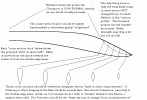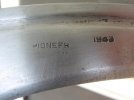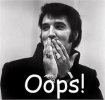shortwinger
Gold Member
- Joined
- Apr 7, 2010
- Messages
- 1,081
Jay,
N2S is correct, every one of the so-called imperfections in the traditional kukri improve chopping. The hollow forging, the hammer indentations the not-so-straight blades all provide pockets where the material (wood) is not contacting anything. This reduces friction and allows the blade to move further into the wood.
We have to remember that for an ax or a hatchet or a kukri, the job of the edge is to break into the wood, where as the bevel's job is to bust the material apart and move it away from the edge so it can sink deeper. If the edge and bevel do not work "with" each other then all you have is a bent leaf spring with a filed edge or, as I like to call it a metal brick. This is at the heart of my problem with making models on a whim and making things up as you go along. That is fine if you are a one-off knife artist but when you are looking for a heavy chopper or a martial arts weapon or a camping kukri you should know what to expect. The models have the features and specs that they do for a very good reason, they work! They work for people who work with them daily so, many many many refinements have been made to the design of the years, not for looks or because it sells but, because it works better.
I hate using the KLO term because it stinks of elitism and superiority but I can say from a lot of personal use that few modern made traditional kukri can hang in there with some of the better made so-called KLO's. The handles, edges and sheaths of most of the traditional kukri are destroyed before you scratch the blade of a modern kukri. This may sound as though I like the modern machine made kukri more than the traditional models but nothing could be further from the truth. I love and cherish my real traditional Nepalese and Indian kukri but, good ones are few and far between. Modern authentic ones "made to specs" are virtually impossible to find at any price.
So I agree with n2s that the lines that define the term KLO can very definitely be blurred and hard to follow. It isn't necessary to talk down the modern kukri to make the traditional kukri special. They are both special to me. Some are better users and some are just for lookin...
N2S is correct, every one of the so-called imperfections in the traditional kukri improve chopping. The hollow forging, the hammer indentations the not-so-straight blades all provide pockets where the material (wood) is not contacting anything. This reduces friction and allows the blade to move further into the wood.
We have to remember that for an ax or a hatchet or a kukri, the job of the edge is to break into the wood, where as the bevel's job is to bust the material apart and move it away from the edge so it can sink deeper. If the edge and bevel do not work "with" each other then all you have is a bent leaf spring with a filed edge or, as I like to call it a metal brick. This is at the heart of my problem with making models on a whim and making things up as you go along. That is fine if you are a one-off knife artist but when you are looking for a heavy chopper or a martial arts weapon or a camping kukri you should know what to expect. The models have the features and specs that they do for a very good reason, they work! They work for people who work with them daily so, many many many refinements have been made to the design of the years, not for looks or because it sells but, because it works better.
I hate using the KLO term because it stinks of elitism and superiority but I can say from a lot of personal use that few modern made traditional kukri can hang in there with some of the better made so-called KLO's. The handles, edges and sheaths of most of the traditional kukri are destroyed before you scratch the blade of a modern kukri. This may sound as though I like the modern machine made kukri more than the traditional models but nothing could be further from the truth. I love and cherish my real traditional Nepalese and Indian kukri but, good ones are few and far between. Modern authentic ones "made to specs" are virtually impossible to find at any price.
So I agree with n2s that the lines that define the term KLO can very definitely be blurred and hard to follow. It isn't necessary to talk down the modern kukri to make the traditional kukri special. They are both special to me. Some are better users and some are just for lookin...









